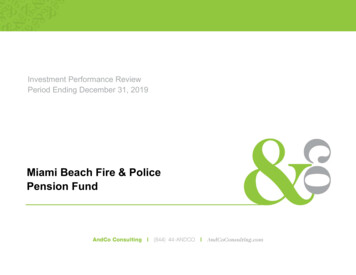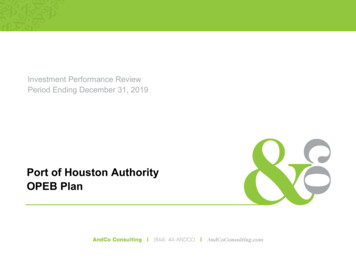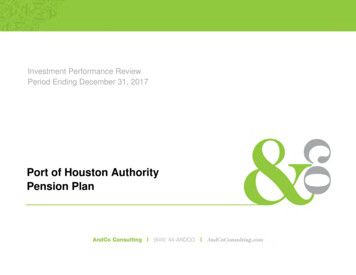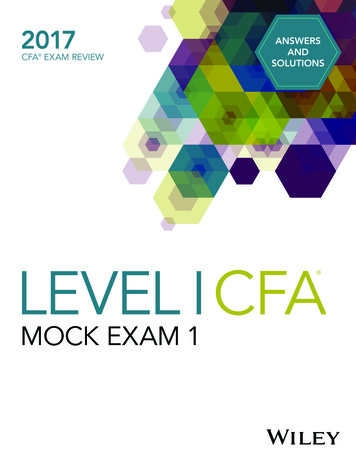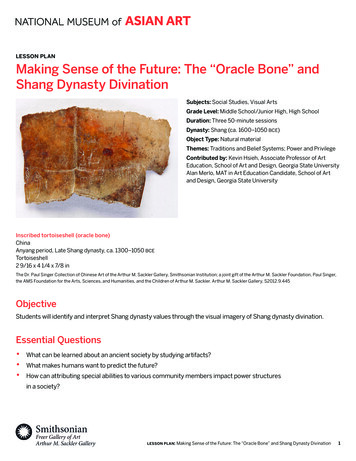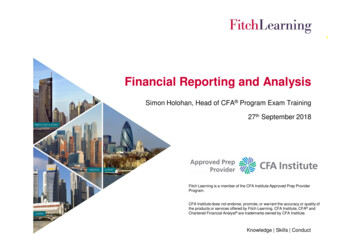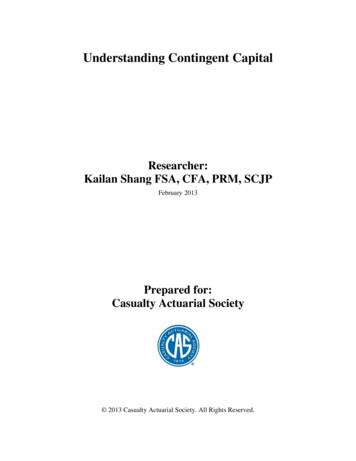
Transcription
Understanding Contingent CapitalResearcher:Kailan Shang FSA, CFA, PRM, SCJPFebruary 2013Prepared for:Casualty Actuarial Society 2013 Casualty Actuarial Society. All Rights Reserved.
Understanding Contingent CapitalUnderstanding Contingent CapitalKailan Shang FSA, CFA, PRM, SCJPAbstract. This paper is a response to the Casualty Actuarial Society’s request for proposals on "ContingentCapital". In light of the recent financial crisis, contingent capital, a type of hybrid security, is seen as aninnovative way of recapitalization given the occurrence of a specified event, such as the capital adequacy ratiofalling below the threshold. Although it has gained prominence among regulators, there are some doubts frommarket participants. The effectiveness of this automatic bail-in hybrid security is still too early to tell given thelimited market experience and unclearness of the impact on the share price when the conversion is triggered. Thegoal of this research is to explore the key features of contingent capital, its market, the appropriate pricing andvaluation tools, and its application in insurance industry. It is hoped that the research will increase ourunderstanding of contingent capital and facilitate the assessment of its value and risk.Motivation. As a new alternative of raising capital automatically under stressed situations, contingent capital isexpected to have more weight on insurers' balance sheets in the future. It is important for actuaries to understandcontingent capital and have the necessary tools to assess its risk.Method. This paper provides an overview of the contingent capital market, its features, and its potential impact.It also discusses the pricing and valuation models for certain contingent capital instruments. A case study isincluded to illustrate the quantitative analysis for a contingent capital instrument.Results. A spreadsheet model is built and used in the case study. It is capable of pricing and valuing certain typesof contingent capital. Quantitative risk analysis and model calibration function is also included. It could serve asgood education materials to understand the role of contingent capital, quantify its risk and assess its effectivenessof absorbing loss.Conclusions. Contingent capital is a promising candidate to improve the capital position of the financialindustry with a smaller cost than additional rights issuance. However, further analysis and test are needed to findout the appropriate design and better understand its potential impact and related stakeholder behavior. There isstill a journey to go before the success.Availability. The spreadsheet “CONTINGENT CAPITAL QA TOOL” that illustrates the quantitative analysisof contingent capital is available together with the report.Keywords. capital management, contingent capital, CoCo bond, systemic risk 2013 Casualty Actuarial Society2
Understanding Contingent CapitalTable of ContentsUNDERSTANDING CONTINGENT CAPITAL . 1EXECUTIVE SUMMARY . 41. INTRODUCTION . 51.1 Research Context . 51.2 Objective . 51.3 Outline. 52. CONTINGENT CAPITAL MARKET . 62.1 Market Overview . 62.2 Do We Need Contingent Capital?. 72.3 Designs of Contingent Capital . 82.4 Stakeholder Analysis . 92.5 Some Doubts about Contingent Capital. 133. KEY FEATURES . 153.1 Trigger event: rule based or discretionary . 153.2 Trigger event: institution level and/or industry level . 163.3 Trigger event: based on book value or market value . 173.4 Conversion Price . 183.5 Market Manipulation . 193.6 Multiple Equilibria . 203.7 Proposals . 213.8 Post Conversion . 243.9 Contingent Capital versus Other Risk Transfer Instruments . 244. EFFECTIVENESS AND POTENTIAL IMPACT . 274.1 The Impact on Systemic Risk . 274.2 Dilution of Shareholder Value . 284.3 Capital Admittance and Accounting Treatment . 284.4 Tax Deductibility . 314.5 Disclosure Requirement . 314.6 Counterparty Risk Assessment . 325. PRICING, VALUATION, AND RISK ASSESSMENT. 335.1 Pricing Models . 335.2 Valuation Models and Assumption Setting . 405.3 Risk Assessment . 436. CASE STUDY . 456.1 Pricing . 466.2 Valuation . 536.3 Risk Assessment . 547. CONCLUSION . 57Acknowledgment . 58Supplementary Material . 58APPENDIX A. QUICK GUIDE FOR CONTINGENT CAPITAL QA TOOL . 59APPENDIX B. MORE FORMULAS USED IN THE CASE STUDY . 598. REFERENCES . 64Biography of the Author . 67 2013 Casualty Actuarial Society3
Understanding Contingent CapitalEXECUTIVE SUMMARYThe financial industry was quite successful in financial instruments innovations to meet the needsof investors. The wide development of the financial derivative market has been providing hedgingtools to transfer financial risks for institutional investors. The insurance industry provides risktransfer as well, built on pooling the individual insurance risks together, and provides protection at areasonable and affordable price. Using reinsurance and alternative risk transfer instruments that arenormally linked with catastrophe risk, risk mitigation activities are prevalent in insurance industry.However, they may not be sufficient to survive a financial crisis. Firms failed for different reasonsbut clearly they held insufficient capital for the risks they took. A huge amount of money was paidby taxpayers to keep some systematically important firms merely alive. The cost was supposed to beborne by the investors. The regulators and the financial industry are taking steps to adopt a morestringent capital rule. Contingent capital caught a lot of attention as a candidate to strengthen thecapital position, reduce the cost of financial crisis borne by the taxpayers, and limit the increasingcost of capital due to more stringent capital requirements. Generally speaking, contingent capitalprovides automatic recapitalization by converting the debt instrument to equity when the issuer is introuble. The trigger of the conversion is based on pre-specified condition such as equity pricedropping below a certain amount or regulatory capital ratio dropping below a certain level, etc. Thisinnovation links the automatic bail in with the capital position of the company, covering a muchbroader scope of risks than ever before.Several companies issued contingent capital instruments, either as a solution for the stressedfinancial condition, or as an action to boost up the capital buffer for future adverse events. There aremany proposals of contingent capital design from the academic community as well. The prevalenceof different opinions of the appropriate trigger event for conversion implies the complexity ofcontingent capital and the immaturity of the market. There are concerns about the stakeholders’rational behaviors that may push the firm down to an even worse situation. This is exactly oppositeto what the contingent capital is designed for. Other concerns include the softening of debt’sdisciplining power and its effectiveness. There is a lot to explore and test in the market beforecontingent capital becomes a widely accepted instrument for prudent capital management and riskmanagement.This paper introduces the background of contingent capital, its key features, the potential impact,and the models for pricing, valuation and risk assessment. It explains the reasons for issuingcontingent capital as well as the major concerns about it. It also includes a case study illustrating thepricing, valuation, and quantitative risk analysis of a sample contingent capital instrument. 2013 Casualty Actuarial Society4
Understanding Contingent Capital1. INTRODUCTIONThis paper is a response to the request for proposals on contingent capital by the Committee onValuation, Finance, and Investments (VFIC) of the Casualty Actuarial Society (CAS).1.1 Research ContextInsurance industry has been utilizing non-traditional capital instruments to transfer risks for along time. Some of them helped insurers absorb losses and retain their capital in adverse events. Forexample, catastrophe bonds or catastrophe equity put arrangements protect the insurers fromcatastrophe losses. Those instruments are normally related to insurance risk, such as naturaldisasters, mortality, and longevity.In the recent financial crisis, systemic risk caught a lot of attention. Much discussion happenedon how to prevent or mitigate systemic risk. Regulators are also changing their ways to regulatethose too-big-to-fail, or systematically important financial institutions. Contingent capital, aninnovative type of automatic bail-in hybrid security, is considered as a candidate for providing capitalat a predetermined cost in stressed situations and for mitigating systemic risk. Contingent capitalinstruments are similar to non-traditional capital instruments used by insurance companies exceptthat the trigger is based on financial conditions instead of insurance risk. Different designs ofcontingent capital have been proposed and some of them are implemented. Though theireffectiveness is still too early to tell, it is important for us to understand them and be equipped withknowledge and analytical tools for valuation and risk assessment.1.2 ObjectiveThe objective of this paper is to explore the key features and characteristics of contingent capitalinstruments, their effectiveness in risk transfer, and the pricing and valuation tools for them. Aquantitative illustrative tool is made available for contingent capital evaluation and risk assessment. Itis hoped that the tool will aid the actuarial community in understanding contingent capital from theperspective of risk transfer and capital management.1.3 OutlineThe remainder of the paper proceeds as follows. Section 2 will give us an overview of thecontingent capital market. Section 3 will discuss the key features of contingent capital instruments.Section 4 will present their impact and effectiveness in risk mitigation and capital management.Section 5 will explore modern finance theory and quantitative models used in pricing, valuation, andrisk reward analysis. It is followed by a case study of evaluating a sample contingent convertiblebond in Section 6. Section 7 will conclude the paper. 2013 Casualty Actuarial Society5
Understanding Contingent Capital2. CONTINGENT CAPITAL MARKETContingent capital instruments, also known as contingent convertible bonds (CoCo bonds),contingent surplus notes, or enhanced capital notes, provide a mechanism that automatically convertthe instruments to equity upon the occurrence of some specified trigger event. These instrumentsbegan to attract attention and gain popularity during the financial crisis in 2008. Before that,insurance companies protected themselves from capital deficiency under stressed situations byreinsurance arrangements, hedging programs, and capital raising. Those seem effective whensystemic risk is mild in the financial system. However, the recent financial crisis told us that whensystemic risk is prevalent, the cost of raising capital may be unaffordable. Much higher liquidity riskand counterparty risk might still put the company in a weak solvency position. Contagion impact ismaterial and the market and regulators have been looking for capital instruments that provide betterinsulation. Contingent capital appears to be the most promising solution although doubts about itare not rare.2.1 Market OverviewThe insurance industry has been utilizing contingent capital instruments for around two decades.Catastrophe equity puts and contingent surplus notes are the most common types. Catastropheequity puts1 give the insurer the right to sell stocks at a fixed price in case a specified trigger eventhappens. Contingent surplus notes2 give insurer the rights to issue surplus notes in exchange forliquid assets upon the occurrence of a predefined trigger event. The size of the transaction rangesfrom a few million dollars to around half a billion dollars. However, the trigger events, or in otherwords, the risks from which the companies have been protected are normally catastrophe riskrelated. The term of the protection is also relatively short.Contingent capital with a trigger event based on regulatory solvency ratio instead of insurancerisk caught public attention in Lloyds Banking Group's exchange offer announced in November2009. It intended to exchange certain existing securities3 for enhanced capital notes or rights issue4.The enhanced capital notes (ECNs) will be converted to ordinary shares if the core tier 1 capitalratio falls below 5%. Not only the unprecedented size for contingent capital issuance but also the1 CEIOPS,“Insurance Linked Securities,” 5.CEIOPS, “Insurance Linked Securities,” 5.3 Existing securities subject to exchange offer comprised of "Upper Tier 2 securities in an aggregate principal amountof 2.52 billion, innovative Tier 1 securities in an aggregate principal amount of 7.68 billion and preference shares (orequivalents) with an aggregate liquidation preference of 4.09 billion", Lloyds Banking Group, “Exchange Offer,” 2.4 The package was supposed to "(i) generate at least 7.5 billion in core tier one and/or nominal value of contingent coretier 1 capital through the Exchange Offer and/or related arrangements; and (ii) raise 13.5 billion ( 13 billion net ofexpenses) by way of a Rights Issue, Lloyds Banking Group, “Exchange Offer,” 1.2 2013 Casualty Actuarial Society6
Understanding Contingent Capitalgovernment's big stake in the company made this transaction very special. Contingent capital isconsidered more favorable than old fashioned hybrid securities such as convertible bonds andpreferred shares under stressed scenarios. These traditional hybrid securities are not as good ascontingent capital instruments in loss absorbing.In addition to conversion to equity if the trigger event happens, some other arrangements werealso experimented. In 2010, Rabobank issued 1.25 billion 10-year Senior Contingent Note. Oncethe capital ratio falls below 7%, the face amount will be written down to 25% and paid back toinvestors. Liability value will be reduced given the trigger event happens, which effectively is acapital injection. This is different from contingent convertible bonds where only the debt/equityratio changes but the amount of capital remains the same if conversion is made at market price.The 500 million deal of contingent convertible bonds between Allianz and Nippon Life in Mid2011 demonstrated the high interest of the insurance industry in using contingent capital to improveits capital position and reduce its risk exposure.Not only banks and insurance companies, other financial institutes have used contingent capital.In the merger of Yorkshire Building Society and Chelsea Building Society in 2009, 200 millionsubordinated securities of Chelsea Building Society were planned in exchange for contingentconvertible bonds. Once the core tier 1 capital ratio falls below 5%, they will automatically beconverted into equity. 52.2 Do We Need Contingent Capital?Before diving into the details about contingent capitals, it is worthy understanding the reasons forbringing contingent capital into the capital structure. From the regulators' perspective, it is hopedthat contingent capital could solve the too-big-to-fail problem and reduce the loss paid by taxpayersinstead of the investors. Compared to issuing new stocks, investors want to take advantage of thedebt-like feature of the contingent capital: tax deductibility before the conversion and upfront andfixed recapitalization cost at conversion.As seen in the financial crisis since 2008, lots of too-big-to-fail companies needed governmentbailout to merely survive. The bad outcomes of writing riskier business than that the available capitalcan support were borne by the taxpayers, not the investors who made the business decision. Highercapital requirement could certainly reduce the chance of going default. However, as Bolton andSamama (2011) pointed out, the foreseen increased capital requirement for bank industry according5A list of contingent capital instruments issued in the past few years is given in Goldman Sachs, “Contingent capitalPossibilities,” 17-18. 2013 Casualty Actuarial Society7
Understanding Contingent Capitalto Basel III may make it more difficult to earn the required return on equity (RoE) if the increasedcapital requirement needs to be met by the issuance of stocks. In addition, a sudden shift to a muchmore stringent capital requirement might also result in a credit crisis as the banks hold a much lessbuffer above the required capital than before or have to raise capital to meet the capital requirement.Contingent capital seems to be a promising solution.(1) As a debt instrument before conversion, it limits the increase in weighted average cost ofcapital (WACC). It will not cause the concern of higher required RoE in normalcircumstances, which happens when financing with common equity.(2) The tax deductibility of the debt instruments is also an argument for investors to utilizecontingent capital in their financing. The disciplining power of creditors might also bepreserved before conversion by maintaining the same leverage level as before.(3) Firms normally try to sell troublesome assets and get rid of troublesome liabilities instead ofissuing new stocks due to its high cost. Issuing contingent capital in good time fixes therecapitalization cost at a reasonable level in a future distressed situation. Apparently it is acheaper way than raising capital in bad time.(4) It can reduce the default probability without government bailout. Upon conversion, thecapital base of the company will be increased so that it will have a stronger capital positionthan that before the conversion. The loss will be borne by the investors of contingent capitalinstead of the taxpayers. Therefore, it helps fulfill the goal of applying more stringent capitalrules to too-big-to-fail firms. Bankruptcy and government bailout are very costly. Contingentcapital can lower the chance of going through those expensive processes.2.3 Designs of Contingent CapitalDespites the skepticism, there is a high and increasing interest in contingent capital instruments.Many designs of contingent capital have been proposed in trying to address the issues mentionedabove. The key differences between different designs so far are about the trigger event and the wayof loss absorbency.Scope of the trigger event. Trigger event can be based on the issuer's financial condition or on anindustry wide indicator. Industry wide indicators, such as an aggregated market loss index orfinancial industry loss index, may be more suitable for mitigating systemic risk. However, it is hardto implement in an objective way and may convey an adverse message to the market.Type of the trigger event. Trigger event can be related to the stock price, regulatory capitaladequacy ratio such as core tier 1 ratio, credit condition such as credit default swap (CDS) spread, or 2013 Casualty Actuarial Society8
Understanding Contingent Capitaleven at the regulator's discretion. Double trigger contingent capital has also been proposed.Level of the trigger point. Going-concern contingent capital normally has a high threshold whilegone-concern contingent capital has a low threshold such as the point of non-viability. Besides theconversion of contingent capital, regulator's intervention is normally expected at the point of nonviability.The way of loss absorbency. After the trigger event happens, contingent capital instruments willbe converted to common equity, or have a write down of face amount and therefore liability. Theimpact is considered to be different. Write-down liability is similar to a capital injection whileconversion to equity is considered as capital restructure.Details of those proposals and their different impacts will be explored in Section 3 and Section 4.2.4 Stakeholder AnalysisRegulators have shown great interest in utilizing contingent capital to absorb losses understressed conditions. It is expected to reduce the need of a government bailout and thereforetaxpayers' support. After a sizable market is developed for contingent capital, the value of issuers,buyers, and existing stockholders and their roles in corporate governance will also be impacted.Rating agencies have also considered the rating methodology for this new type of hybrid securitiesand to what extent it can boost the issuer's financial strength.2.4.1 RegulatorsRegulators have been busy improving the capital adequacy rules to address the issues emergingfrom the financial crisis since 2008. In addition to a higher level of capital requirement, thequalification standard of hybrid securities to meet the additional capital requirement is also one ofthe major focuses. Though the future success of contingent capital is uncertain, it is very likely thatcontingent capital will become a part of the capital structure to meet regulators' requirement.(1) In October 2010, Financial Stability Board (FSB) recommended that global systematicallyimportant financial institutions (SIFIs) should have higher loss absorbency 6 . One of thecandidates that can be used to meet the stringent requirement is contingent capital whichabsorbs loss at the point of non-viability. It was later endorsed by the G20.(2) Basel Committee on Banking Supervision (BCBS) released a rule about the additional lossabsorbency requirement for global systematically important banks (GSIB) in late 2011. BCSChas considered different forms of contingent capital and carefully decided the minimum6FSB, “Reducing the moral hazard,” 3. 2013 Casualty Actuarial Society9
Understanding Contingent Capitalrequirements for going-concern contingent capital in order to meet additional requirementsfor GSIB. Contingent capital will have to be converted to Common Equity Tier 1 when theCommon Equity Tier 1 falls below at least 7% of risk adjusted assets, which is a highthreshold. It is also required to have a cap on the new shares and the full authorization of theissuers for an immediate conversion. The rule is expected to be phased in between 2016 and2018 and become effective in 2019.(3) European Union amended its capital requirements directive (CRD) in 2009, known as CRDII, which highlighted the importance role of hybrid capital instruments in capitalmanagement. Instruments that absorb losses on a going-concern basis and that must beconverted to core tier 1 capital are regarded as equity capital. In 2010, a consultation paper(CRD IV) was issued including possible further changes. It states that the EuropeanCommission will consider the potential need for all non-core tier 1 instruments to have amandatory principal write-down or conversion feature, the potential triggers for conversion,and alternative mechanisms and triggers of contingent capital7.(4) US regulators are also interested in the idea of using contingent capital. As one of theprovisions in the Dodd-Frank Wall Street Reform and Consumer Protection Act, FederalReserve may establish heightened prudential standards for contingent capital requirement. It"authorizes the Board to require each Board-supervised nonbank financial company and bank holdingcompanies with total consolidated assets of 50 billion or more to maintain a minimum amount of contingentcapital convertible to equity in times of financial stress." 8 The Fed is in discussions with bankers.Unlike the existing contingent capital deals that have trigger events related to the issuer's owncapital ratio, the Fed is also exploring a system wide trigger.(5) Office of the Superintendent of Financial Institutions Canada (OSFI) issued its final advisoryon Non-Viability Contingent Capital. Seen as a fast movement on implementation of BaselIII, it requires that the regulatory capital of all federally regulated deposit-taking institutions(DTIs) must have loss absorbing quality when the DTI fails. All the non-common Tier 1 andTier 2 capital must satisfy the requirement for non-viability contingent capital (NVCC).Unlike CoCo bonds, the trigger event of NVCC is dependent on the regulators'announcement, either from OSFI, or federal/provincial government. Though it sounds likeregulators have a lot of discretion, non-viability is determined based on clearly defined criteriawhich would mitigate the chance of discretion. Interestingly, this is more like a low trigger7 COMMISSION8SERVICES STAFF WORKING DOCUMENT, "POSSIBLE FURTHER CHANGES," 18-19&23.Sec 165, “Enhanced supervision,” H.R.4173 2013 Casualty Actuarial Society10
Understanding Contingent Capitallevel, gone concern type of contingent capital compared to the high trigger level, goingconcern contingent capital required for GSIB by BCBS.(6) Under the Solvency II framework, contingent capital with appropriate feature can beclassified as ancillary own fund 9 (AOF). AOF can be used to meet the solvency capitalrequirement (SCR) but not the minimum capital requirement (MCR). However, according tothe directive, the total amounts and the amount for each AOF item are subject to supervisoryapproval. The recoverability, legal form, and any past exercise need to be taken into accountwhen determining the amount qualified for AOF.10(7) In August 2010, National Association of Insurance Commissioners (NAIC) SecuritiesValuation Office (SVO) reported on contingent capital securities. Considering that there is noagreement on the design of the trigger event, the task force did not draw any conclusion butdecided to continue monitoring the development of contingent capital.It is clear that contingent capital is one of the priorities of regulators regarding regulating SIFI butthere is still work that needs to be done for further assessment and refinement. Regulators underdifferent jurisdictions may also have different opinions regarding the details.2.4.2 IssuersIn order to meet more stringent capital requirements, financial institutions can either raise morecommon equity or issue cont
This paper provides an overview of the contingent capital market, its features, and its potential impact. It also discusses the pricing and valuation models for certain contingent capital instruments. A case study is included to illustrate the quantitative analysis for a contingent capital instrument. Results. A spreadsheet model is built and .

